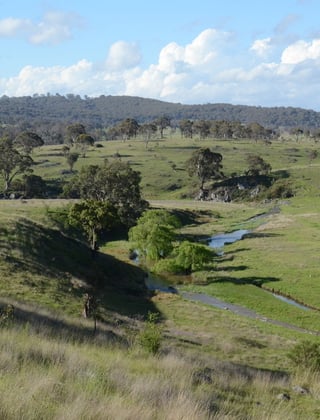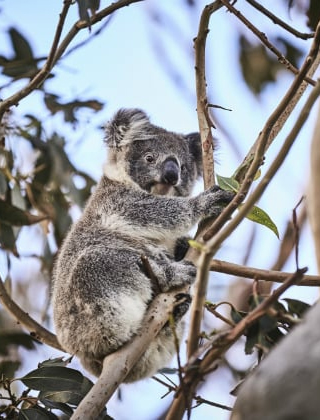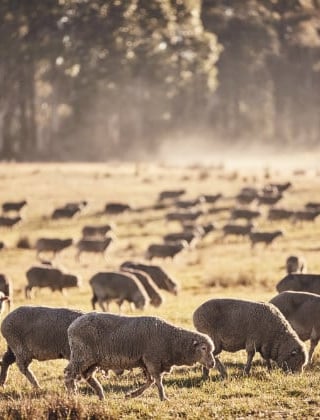Sustainability focus looks to the future
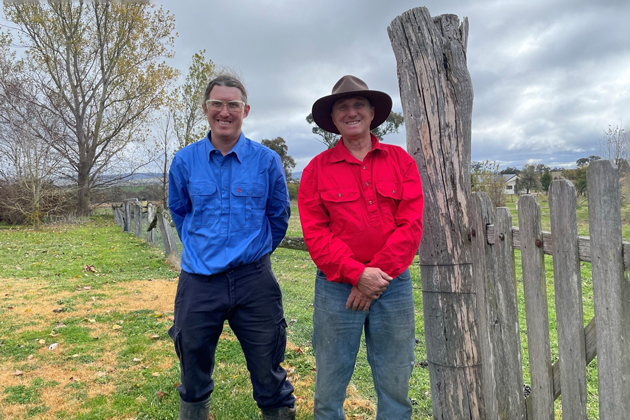
The Ross family of Bathurst on the Central Tablelands of NSW has implemented changes on its farm to improve drought resilience, increase biodiversity and provide a better grazing environment for their sheep.
Simon Ross and his father Graeme on their ‘Willow Glen’ property near Bathurst, NSW.
GWS Ross is a family-run superfine wool-growing business operating on 846 hectares of undulating granite country at ‘Willow Glen’ just south of Bathurst. The property has been in the Ross family since the 1940s when it was bought for Cam Ross and his brother, who were then teenagers, by their father.
The property is now run by Cam’s son Graeme with his wife Wendy, and grandson Simon who with his wife Nikki have a young daughter Georgia who also loves the farm.
Simon says that reinforcing their property’s environmental sustainability is important to ensure the financial viability of the business.
“Making sure that both our business fundamentals and our environmental practices are as sustainable as possible is vital. They need to work together, otherwise the business would face increased risk, especially with a changing climate,” Simon said.
“My philosophy as a woolgrower is to produce as much wool as we can from as few sheep as we can, maximising the ecological and environmental benefits of the farm.”
Turnaround in the farm’s resilience
Ever since ‘Willow Glen’ was purchased, the Ross family has been regenerating the land on the property, which continues to this day, thereby helping to ensure the profitability and sustainability of the business for years to come.
“When my grandfather started out on the property, I think it was quite run down and some large gullies had developed. It had obviously been run hard,” said Simon.
“So, the family set about trialling and implementing ways to rebuild the health of the landscape. For example, the property was contoured early on, gullies and riparian zones have all been fenced off, and a massive number of trees continue to be planted.
“In the 1960s, the family started rotational grazing. They used a fast rotation for quite a while, but then in about 2006, Dad decided to go further: slowing down the rotation, with bigger mobs and longer rest periods, while going into the regenerative ag space.”
Simon says there has been a remarkable turnaround in the farm’s resilience, which is especially important in the face of a variable climate.
“We’re now definitely reliant on a lot less inputs – for instance, instead of applying superphosphate every year, we re-fertilise only when we’re putting in fodder crops and the like. Our reduced financial outlay on inputs makes the business more profitable.
“We are also able to capture a lot more of the rain we receive here, with much less runoff, resulting in more than 75% permanent ground cover.
“One of the important lessons that I’ve learnt is to move fast and early when coming into dry times, so decreasing stock size to match carrying capacity. There has of course been trial and error – during our first drought we had mobs that were too big in size that we didn’t decrease quickly enough, and all of a sudden the paddocks were losing feed in two days rather than four.”
Tree lots benefit the business
A major change implemented on the property has been the planting of trees, with more than 48,000 trees planted since 2006. Tree cover is now about 140 hectares (>16% of the property) and Simon says they have a plan for the property to reach 25% tree cover.
“We have a lot of big, wide, biodiverse tree lots: 50/50 trees and shrubs. There are a lot of yellow box and red box. We’ve collected our own seed and grown about 10,000 of the 48,000 trees ourselves, planting between 500 and 2,000 each year,” Simon said.
The Rosses grow the trees mostly along the ridgelines, to get the double advantage of windbreak and biodiversity, which Simon says is very beneficial.
“Now that most of the trees are fairly established, they provide our sheep with a lot of shelter. It’s beneficial for lambing ewes; if it’s going to be a cold week, we’ll open a tree lot and let the ewes go in and get a little bit more shelter, which helps with lamb survival and marking rates. Also, during dry periods, we don’t put out hay, we just open up the tree lots and the sheep go in and eat the long grass.
“However, the value of tree lots extends beyond the fence and into the paddock, such as from the beneficial effect of insects.
“We’re also thinking of planting fodder shrubs, such as wattles and tree lucerne, in the middle of paddocks to provide even more shelter and diversity of feed, especially for dry times because trees or shrubs are more resilient than grass.”
Optimism for the future
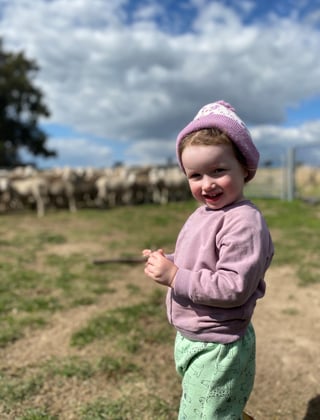
The fourth generation Ross on the property, Georgia, inspecting the ewes.
While acknowledging that the wool industry faces challenges, Simon says he’s optimistic about the future of wool and agriculture in general.
“Although some people criticise livestock producers about things like methane, I think the benefits of agriculture and especially regenerative type livestock agriculture such as wool-growing far outweigh any negatives,” he said.
“I don’t mind the label of ‘regenerative agriculture’. It’s a good label because it describes quite well what we are doing and the improvements we aim to make.
“I think woolgrowers need to emphasise more the good work that they do for their land. We need to tell our eco story and the positive things we are doing to capture and store carbon on our properties. I think that will be better for woolgrowers in the long term, rather than allowing other people to use our carbon as offsets, just to make a little bit of quick cash.”
Simon advises woolgrowers to take the long view when making changes to their property, especially in a grassland environment, because positive results can take time to come to realisation.
“Certainly plan well, but once you have made a decision, you have to just go for it, no half measures. For example, when we stopped mulesing, we just stopped and it meant we didn’t look back. And we would never look back now.”
Value of research and planning
Simon advises that careful research and planning is crucial for woolgrowers who are considering making changes to the way they run their businesses.
The Rosses themselves have been involved in various trials and research projects on their own farm to improve their business’s sustainability. This research has not only been important in ensuring their business’s long-term viability, but it also won them this year’s Boehringer Ingelheim Industry Innovator award at the ACM Agri 2023 Lambition Awards.
Announced in July during the Australian Sheep & Wool Show in Bendigo, these awards recognise the contribution from the country's most prestigious sheep and wool producers in regard to sustainability, leadership, innovation and production.
An example of the research in which the Rosses have been involved on their farm include the Grazing For Drought project, overseen by their local Landcare network, which aims to help producers improve their drought resilience using adaptive planned grazing. Simon says the project included a field day to understand how to maximise production during drought, and a trial to implement the practice.
“We set up pens and grazed our sheep at different rotations to determine the optimum length of rest that would allow us to keep 100% ground cover and enable us not to destock too much in a drought,” Simon said.
“We have also begun to use data collected from our sheep’s electronic IDs, so that we are ready and able to sell our least productive stock first if and when we get into drought conditions.”
Another example of research they have been involved with is the MerinoLink Sire Evaluation Trial. About 200 woolgrowers visited their farm in June as part of the MerinoLink annual conference to see their progeny on display. The Rosses also presented information to the visitors on how they are establishing containment lots as part of their goal to maintain 100% ground cover.
“We think it is important for us to be involved in MerinoLink Sire Evaluation as much of the data we have generated is valuable to other woolgrowers, plus it’s a good learning experience for us too,” Simon added.
This article appeared in the September 2023 edition of AWI’s Beyond the Bale magazine. Reproduction of the article is encouraged.






